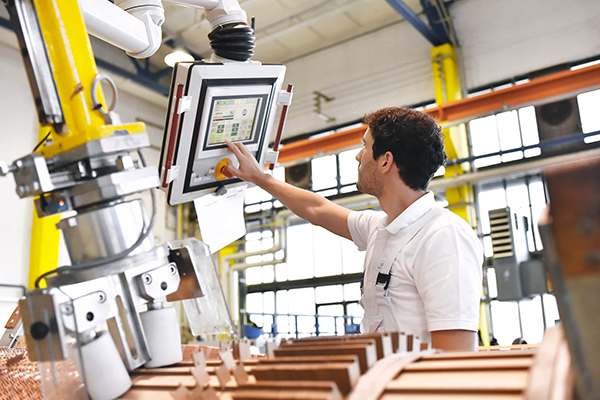Scott Sherman, QAD’s VP of Global Talent, honors manufacturing labor during this Labor Day – the backbone of our industry who keep it moving.

While Labor Day started as a holiday for a limited number of workers in specific occupations, the day now honors all workers. It is especially significant to manufacturing workers who lobbied so hard on behalf of everyone who holds down a job.
Manufacturing is the backbone of a strong economy, and it plays a major role in both the local and the national economy. According to the Manufacturing Institute, for every dollar spent on manufacturing salaries in a community, another $2.79 enters the local economy for supporting roles, making manufacturing the economic sector with the highest multiplier effect.
According to the US Bureau of Labor Statistics, about 12.3 million people were employed by the manufacturing sector, making it the largest source of employment other than government. Yet more than 2 million manufacturing openings will remain unfilled through 2025 due to lack of the necessary skills and worker misperceptions about the jobs.
For example, the common perception that manufacturing jobs have low earnings potential is unfounded. The average compensation for hourly manufacturing workers was $64,014, and salaried workers earned $111,731, according to a 2018 research report from the SME Education Foundation. These numbers are true even for workers who have only a high school or vocational school diploma, so it is possible to earn an excellent living without the burden of student loans necessary for advanced degrees.
Even more important, 67% of workers in manufacturing reported being satisfied or very satisfied with their current employment.
One of the key reasons that manufacturing salaries tend to be higher than average is because of the continuing rise in industry productivity. According to the US Bureau of Labor Statistics, manufacturing productivity grew by 1.7% between 1987 and 1990; 3.8% between 1990 and 2000; and 4.4% between 2000-2007. Productivity only grew by .2% between 2007 and 2020 as the country struggled with COVID-19, a general slowdown in trade, and competitive threats from China.
Productivity improvements can be attributed to widespread adoption of advanced technologies such as robotics, CNC equipment and artificial intelligence. Use of these modern technologies makes manufacturing an attractive career for people who enjoy working with technology.
A recent study from the Brookings Institute used 20 indicators to develop a scale ranking the manufacturing environment in various countries. Using the scale, the United Kingdom and Switzerland both scored 78 out of a possible 100 points. The US came in third at 77.
The US scored well in its overall business policies, education, and labor productivity, but fared poorly in health care, tax policies and infrastructure spending.
The skills gap adversely affects manufacturing productivity and product costs
The manufacturing industry has been suffering from an erosion of the skills necessary to compete in the modern world. Baby Boomers are retiring and taking their knowledge with them when they go. Younger workers don’t always have the math and science skills necessary to replace the retirees.
In addition, younger workers don’t see manufacturing as a desirable career because of negative perceptions about the industry. They often believe that manufacturing jobs are boring, dirty, dangerous and low-paying, but these perceptions do not fit the reality of modern manufacturing. The industry is an early adopter of some of today’s most exciting technologies, including virtual reality, robotics, artificial intelligence, 3D printing and CNC-controlled equipment.
The manufacturing industry has taken many steps to address the skills gap. For example, many states have launched specialized training programs to equip potential workers with the necessary skills. One highly successful example of this is the South Carolina Manufacturing Certification, which teaches such essential skills as lean Six Sigma, OSHA guidelines, and offers training in STEM skills and a hands-on lab.
Manufacturing executives frequently work with local community colleges and schools to ensure the curriculum includes the math and science skills graduates will need to succeed in manufacturing careers. They sometimes come to the classroom to discuss their own manufacturing experiences, and some companies offer tours of their facilities to schools.
Another successful idea has been to pair up a worker approaching retirement with a new hire to ensure the hard-won skills are passed on. Acting as a mentor to a new generation can be an extremely rewarding experience.
Community outreach programs like National Manufacturing Day can help draw attention to the realities of modern manufacturing, helping younger workers to see the challenge and excitement of the manufacturing industry.
Companies can also help bridge the gap by using adaptive business solutions that can be tailored to follow the company’s exact business processes. This makes it easier to train new employees and helps with job sharing and improving productivity for gig workers.
Labor Day is a good time to thank someone in manufacturing! The recent pandemic showed us all how dependent we are on the manufacturing industry and its robust supply chains. The industry worked hard to ensure a continued flow of necessary goods from essential PPE for health care workers to food, household goods, and work-from-home technology and furnishings. Labor Day is a good time to thank those in the manufacturing industry for their contributions to our economy and our continued comfort and safety.

Scott Sherman joined QAD in August 2019. He is responsible for global talent acquisition strategy and programs across the entire QAD organization. His overall current and long-term responsibilities also involve internal and external resourcing strategies, analysis of global labor market / economic trends, employment brand, candidate experience, expanding in-house sourcing capabilities and passive candidate generation and managing talent acquisition systems and partners.
In this episode, I sat down with Beejan Giga, Director | Partner and Caleb Emerson, Senior Results Manager at Carpedia International. We discussed the insights behind their recent Industry Today article, “Thinking Three Moves Ahead” and together we explored how manufacturers can plan more strategically, align with their suppliers, and build the operational discipline needed to support intentional, sustainable growth. It was a conversation packed with practical perspectives on navigating a fast-changing industry landscape.